Market Segmentation Approaches and Starbucks Positioning Analysis
VerifiedAdded on 2023/06/15
|10
|2981
|454
Report
AI Summary
This report provides a detailed analysis of market segmentation approaches, including demographic, geographic, psychographic, and behavioral segmentation, outlining the advantages and disadvantages of each. It then identifies Starbucks' primary and secondary target markets, justifying the selection criteria based on demographic and socio-economic factors. Finally, the report defines positioning and explains Starbucks' positioning strategy as a high-priced, high-quality coffee brand targeting young generations with average income or earning potential. The analysis also considers Starbucks' adaptive positioning through the development of low-calorie beverages to cater to health-conscious consumers. This student-contributed assignment is available on Desklib, offering insights into marketing strategies and real-world applications.
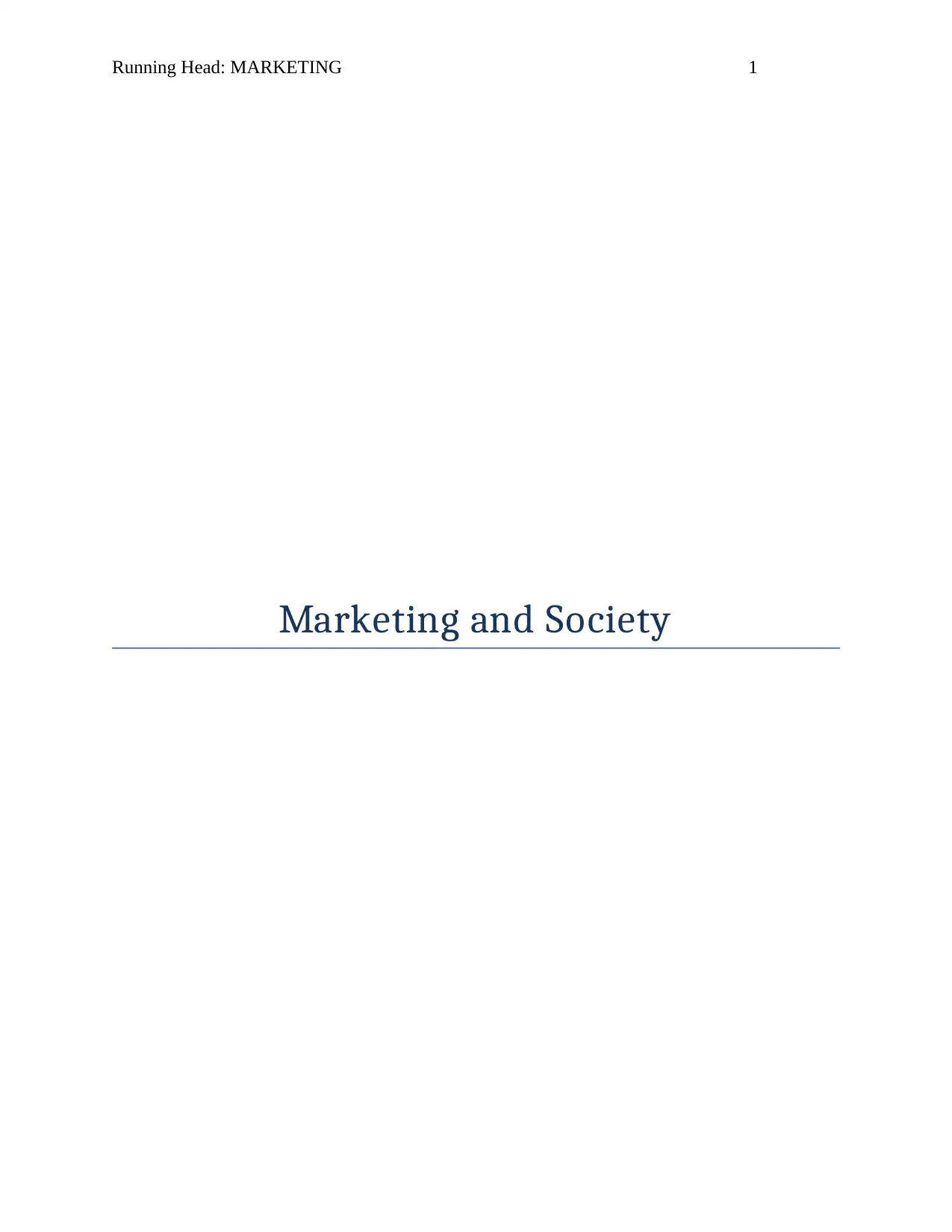
Running Head: MARKETING 1
Marketing and Society
Marketing and Society
Paraphrase This Document
Need a fresh take? Get an instant paraphrase of this document with our AI Paraphraser
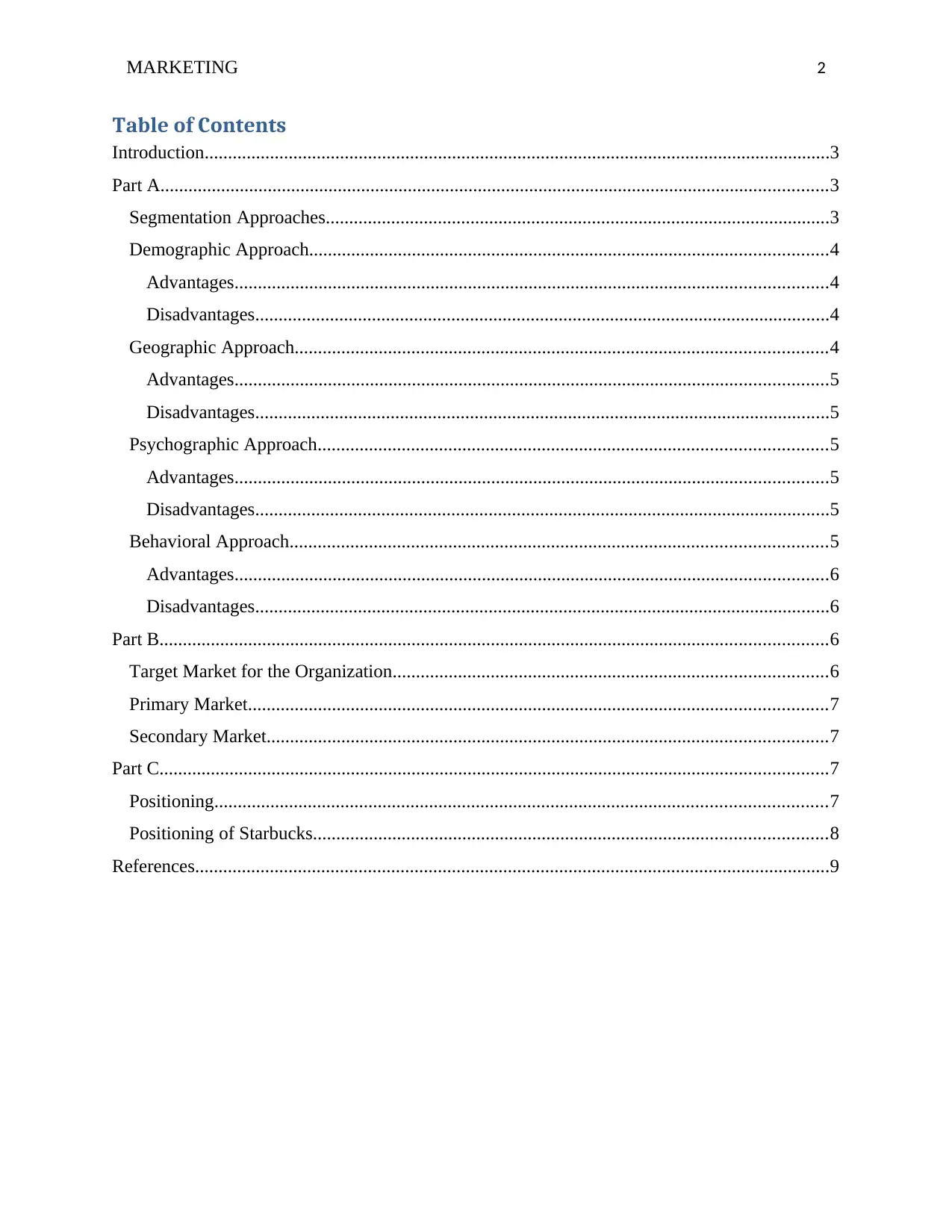
MARKETING 2
Table of Contents
Introduction......................................................................................................................................3
Part A...............................................................................................................................................3
Segmentation Approaches............................................................................................................3
Demographic Approach...............................................................................................................4
Advantages...............................................................................................................................4
Disadvantages...........................................................................................................................4
Geographic Approach..................................................................................................................4
Advantages...............................................................................................................................5
Disadvantages...........................................................................................................................5
Psychographic Approach.............................................................................................................5
Advantages...............................................................................................................................5
Disadvantages...........................................................................................................................5
Behavioral Approach...................................................................................................................5
Advantages...............................................................................................................................6
Disadvantages...........................................................................................................................6
Part B...............................................................................................................................................6
Target Market for the Organization.............................................................................................6
Primary Market............................................................................................................................7
Secondary Market........................................................................................................................7
Part C...............................................................................................................................................7
Positioning...................................................................................................................................7
Positioning of Starbucks..............................................................................................................8
References........................................................................................................................................9
Table of Contents
Introduction......................................................................................................................................3
Part A...............................................................................................................................................3
Segmentation Approaches............................................................................................................3
Demographic Approach...............................................................................................................4
Advantages...............................................................................................................................4
Disadvantages...........................................................................................................................4
Geographic Approach..................................................................................................................4
Advantages...............................................................................................................................5
Disadvantages...........................................................................................................................5
Psychographic Approach.............................................................................................................5
Advantages...............................................................................................................................5
Disadvantages...........................................................................................................................5
Behavioral Approach...................................................................................................................5
Advantages...............................................................................................................................6
Disadvantages...........................................................................................................................6
Part B...............................................................................................................................................6
Target Market for the Organization.............................................................................................6
Primary Market............................................................................................................................7
Secondary Market........................................................................................................................7
Part C...............................................................................................................................................7
Positioning...................................................................................................................................7
Positioning of Starbucks..............................................................................................................8
References........................................................................................................................................9
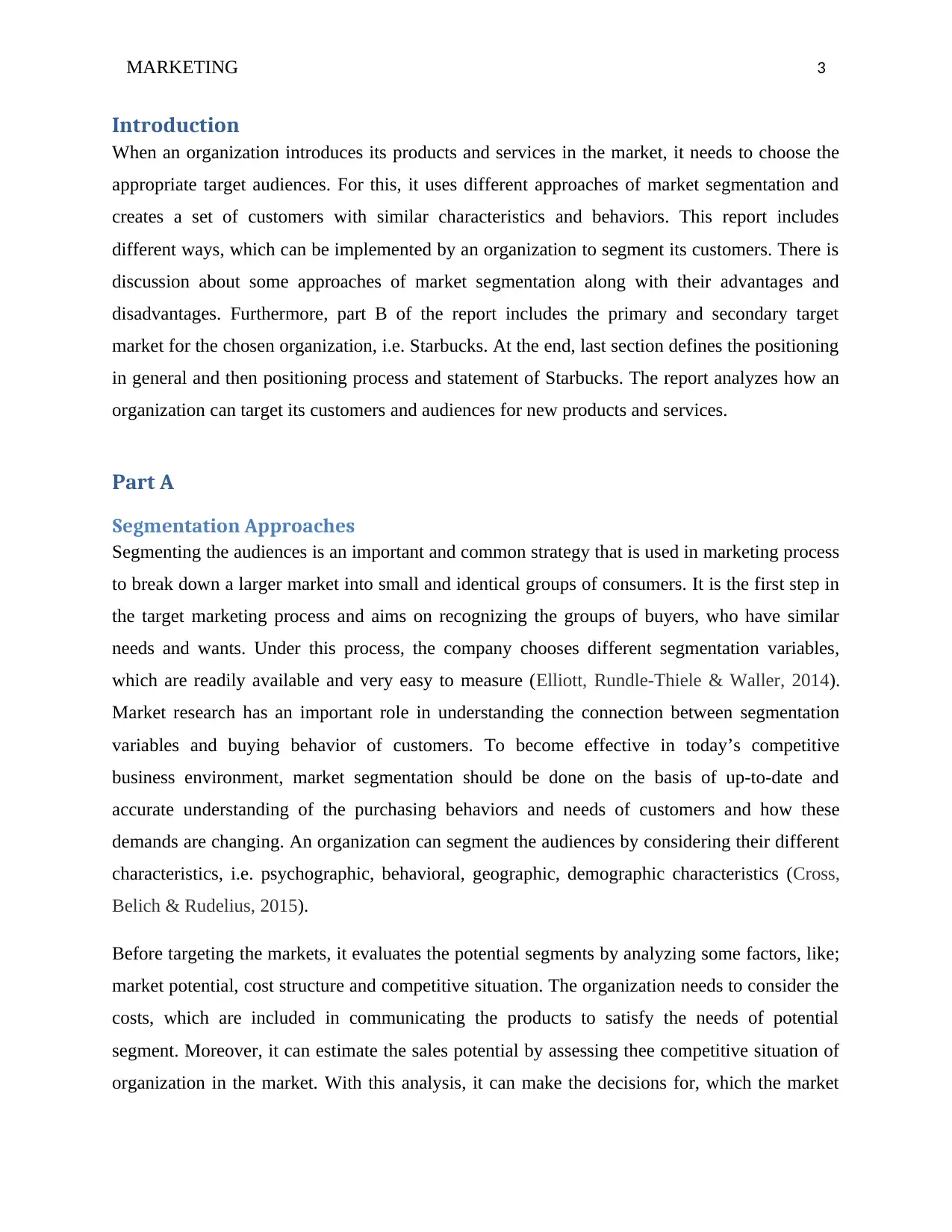
MARKETING 3
Introduction
When an organization introduces its products and services in the market, it needs to choose the
appropriate target audiences. For this, it uses different approaches of market segmentation and
creates a set of customers with similar characteristics and behaviors. This report includes
different ways, which can be implemented by an organization to segment its customers. There is
discussion about some approaches of market segmentation along with their advantages and
disadvantages. Furthermore, part B of the report includes the primary and secondary target
market for the chosen organization, i.e. Starbucks. At the end, last section defines the positioning
in general and then positioning process and statement of Starbucks. The report analyzes how an
organization can target its customers and audiences for new products and services.
Part A
Segmentation Approaches
Segmenting the audiences is an important and common strategy that is used in marketing process
to break down a larger market into small and identical groups of consumers. It is the first step in
the target marketing process and aims on recognizing the groups of buyers, who have similar
needs and wants. Under this process, the company chooses different segmentation variables,
which are readily available and very easy to measure (Elliott, Rundle-Thiele & Waller, 2014).
Market research has an important role in understanding the connection between segmentation
variables and buying behavior of customers. To become effective in today’s competitive
business environment, market segmentation should be done on the basis of up-to-date and
accurate understanding of the purchasing behaviors and needs of customers and how these
demands are changing. An organization can segment the audiences by considering their different
characteristics, i.e. psychographic, behavioral, geographic, demographic characteristics (Cross,
Belich & Rudelius, 2015).
Before targeting the markets, it evaluates the potential segments by analyzing some factors, like;
market potential, cost structure and competitive situation. The organization needs to consider the
costs, which are included in communicating the products to satisfy the needs of potential
segment. Moreover, it can estimate the sales potential by assessing thee competitive situation of
organization in the market. With this analysis, it can make the decisions for, which the market
Introduction
When an organization introduces its products and services in the market, it needs to choose the
appropriate target audiences. For this, it uses different approaches of market segmentation and
creates a set of customers with similar characteristics and behaviors. This report includes
different ways, which can be implemented by an organization to segment its customers. There is
discussion about some approaches of market segmentation along with their advantages and
disadvantages. Furthermore, part B of the report includes the primary and secondary target
market for the chosen organization, i.e. Starbucks. At the end, last section defines the positioning
in general and then positioning process and statement of Starbucks. The report analyzes how an
organization can target its customers and audiences for new products and services.
Part A
Segmentation Approaches
Segmenting the audiences is an important and common strategy that is used in marketing process
to break down a larger market into small and identical groups of consumers. It is the first step in
the target marketing process and aims on recognizing the groups of buyers, who have similar
needs and wants. Under this process, the company chooses different segmentation variables,
which are readily available and very easy to measure (Elliott, Rundle-Thiele & Waller, 2014).
Market research has an important role in understanding the connection between segmentation
variables and buying behavior of customers. To become effective in today’s competitive
business environment, market segmentation should be done on the basis of up-to-date and
accurate understanding of the purchasing behaviors and needs of customers and how these
demands are changing. An organization can segment the audiences by considering their different
characteristics, i.e. psychographic, behavioral, geographic, demographic characteristics (Cross,
Belich & Rudelius, 2015).
Before targeting the markets, it evaluates the potential segments by analyzing some factors, like;
market potential, cost structure and competitive situation. The organization needs to consider the
costs, which are included in communicating the products to satisfy the needs of potential
segment. Moreover, it can estimate the sales potential by assessing thee competitive situation of
organization in the market. With this analysis, it can make the decisions for, which the market
⊘ This is a preview!⊘
Do you want full access?
Subscribe today to unlock all pages.

Trusted by 1+ million students worldwide
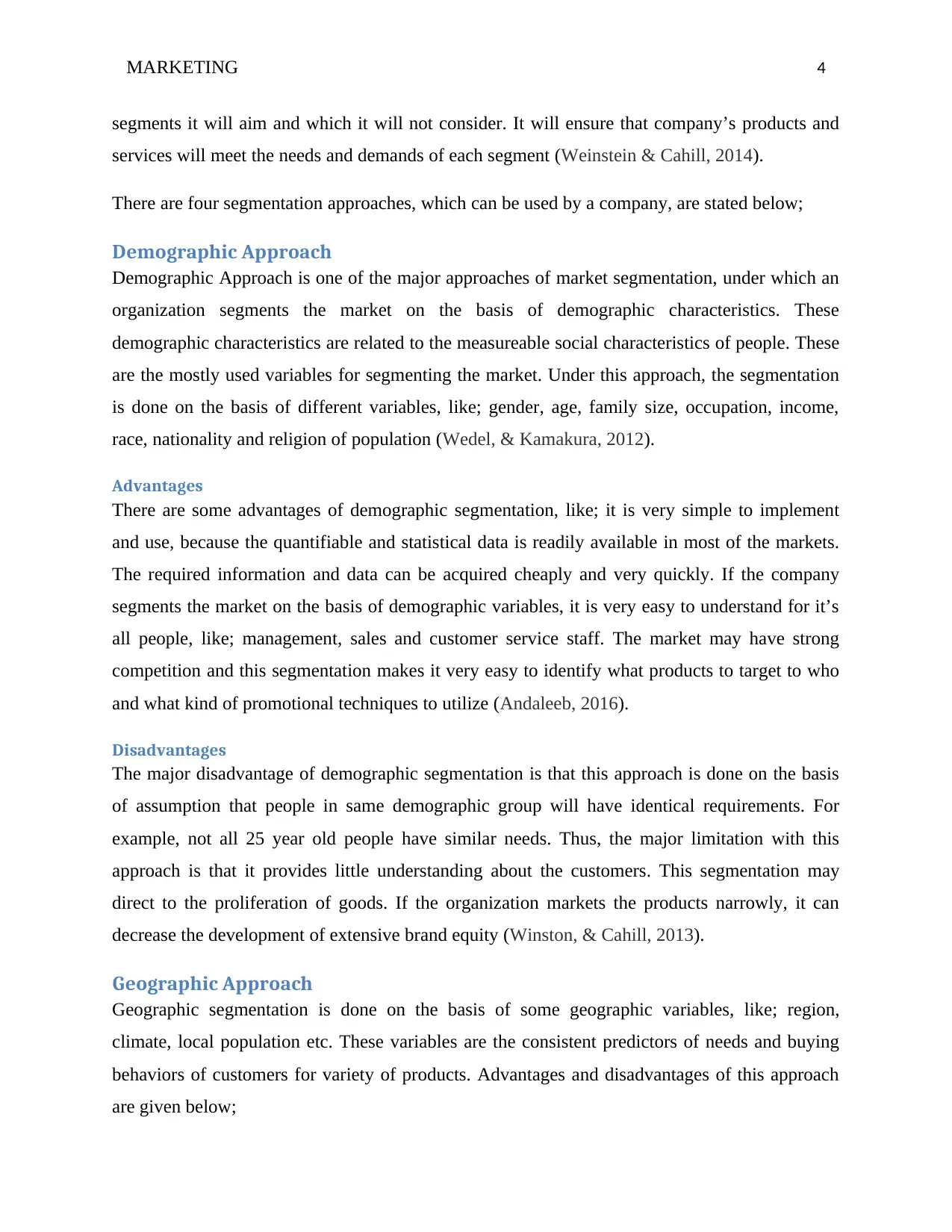
MARKETING 4
segments it will aim and which it will not consider. It will ensure that company’s products and
services will meet the needs and demands of each segment (Weinstein & Cahill, 2014).
There are four segmentation approaches, which can be used by a company, are stated below;
Demographic Approach
Demographic Approach is one of the major approaches of market segmentation, under which an
organization segments the market on the basis of demographic characteristics. These
demographic characteristics are related to the measureable social characteristics of people. These
are the mostly used variables for segmenting the market. Under this approach, the segmentation
is done on the basis of different variables, like; gender, age, family size, occupation, income,
race, nationality and religion of population (Wedel, & Kamakura, 2012).
Advantages
There are some advantages of demographic segmentation, like; it is very simple to implement
and use, because the quantifiable and statistical data is readily available in most of the markets.
The required information and data can be acquired cheaply and very quickly. If the company
segments the market on the basis of demographic variables, it is very easy to understand for it’s
all people, like; management, sales and customer service staff. The market may have strong
competition and this segmentation makes it very easy to identify what products to target to who
and what kind of promotional techniques to utilize (Andaleeb, 2016).
Disadvantages
The major disadvantage of demographic segmentation is that this approach is done on the basis
of assumption that people in same demographic group will have identical requirements. For
example, not all 25 year old people have similar needs. Thus, the major limitation with this
approach is that it provides little understanding about the customers. This segmentation may
direct to the proliferation of goods. If the organization markets the products narrowly, it can
decrease the development of extensive brand equity (Winston, & Cahill, 2013).
Geographic Approach
Geographic segmentation is done on the basis of some geographic variables, like; region,
climate, local population etc. These variables are the consistent predictors of needs and buying
behaviors of customers for variety of products. Advantages and disadvantages of this approach
are given below;
segments it will aim and which it will not consider. It will ensure that company’s products and
services will meet the needs and demands of each segment (Weinstein & Cahill, 2014).
There are four segmentation approaches, which can be used by a company, are stated below;
Demographic Approach
Demographic Approach is one of the major approaches of market segmentation, under which an
organization segments the market on the basis of demographic characteristics. These
demographic characteristics are related to the measureable social characteristics of people. These
are the mostly used variables for segmenting the market. Under this approach, the segmentation
is done on the basis of different variables, like; gender, age, family size, occupation, income,
race, nationality and religion of population (Wedel, & Kamakura, 2012).
Advantages
There are some advantages of demographic segmentation, like; it is very simple to implement
and use, because the quantifiable and statistical data is readily available in most of the markets.
The required information and data can be acquired cheaply and very quickly. If the company
segments the market on the basis of demographic variables, it is very easy to understand for it’s
all people, like; management, sales and customer service staff. The market may have strong
competition and this segmentation makes it very easy to identify what products to target to who
and what kind of promotional techniques to utilize (Andaleeb, 2016).
Disadvantages
The major disadvantage of demographic segmentation is that this approach is done on the basis
of assumption that people in same demographic group will have identical requirements. For
example, not all 25 year old people have similar needs. Thus, the major limitation with this
approach is that it provides little understanding about the customers. This segmentation may
direct to the proliferation of goods. If the organization markets the products narrowly, it can
decrease the development of extensive brand equity (Winston, & Cahill, 2013).
Geographic Approach
Geographic segmentation is done on the basis of some geographic variables, like; region,
climate, local population etc. These variables are the consistent predictors of needs and buying
behaviors of customers for variety of products. Advantages and disadvantages of this approach
are given below;
Paraphrase This Document
Need a fresh take? Get an instant paraphrase of this document with our AI Paraphraser
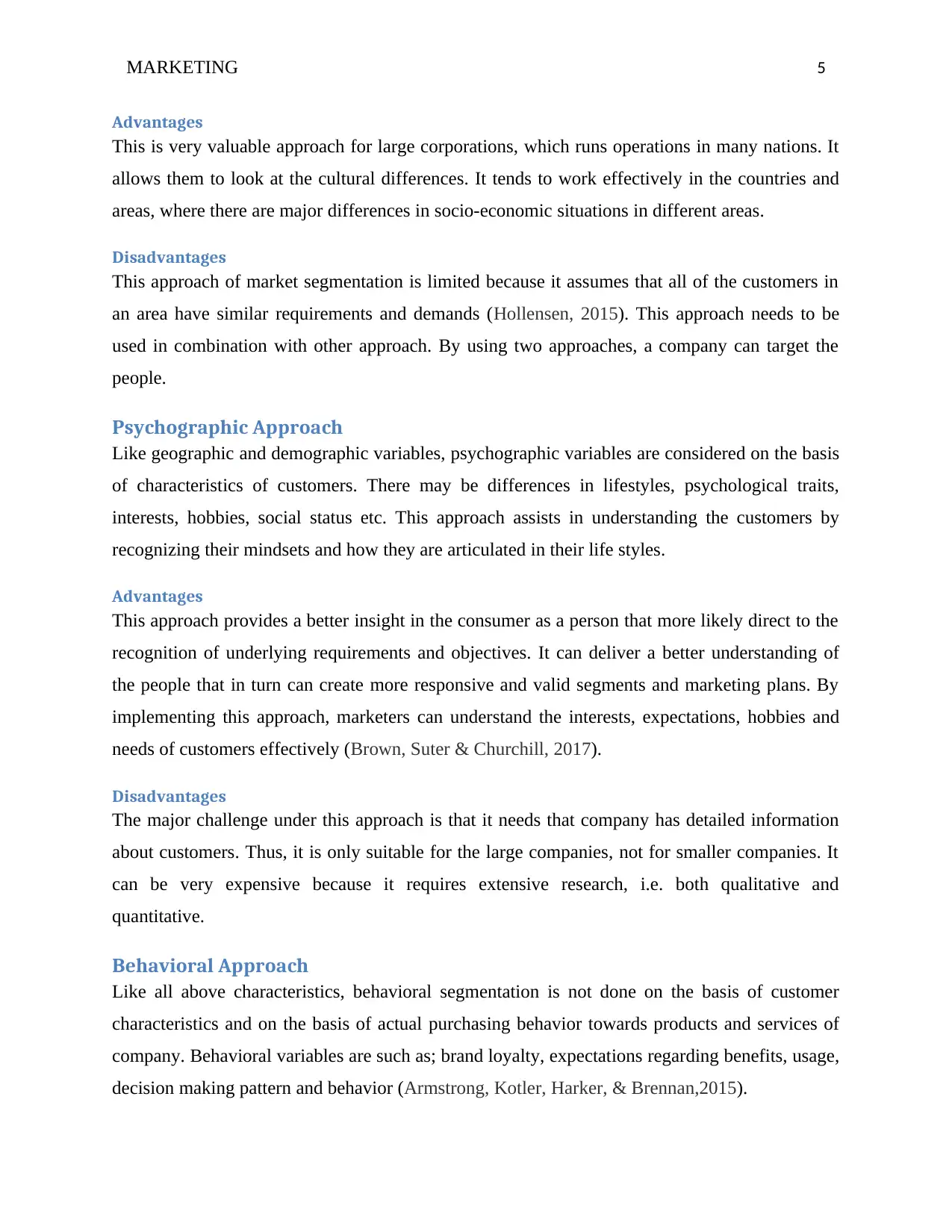
MARKETING 5
Advantages
This is very valuable approach for large corporations, which runs operations in many nations. It
allows them to look at the cultural differences. It tends to work effectively in the countries and
areas, where there are major differences in socio-economic situations in different areas.
Disadvantages
This approach of market segmentation is limited because it assumes that all of the customers in
an area have similar requirements and demands (Hollensen, 2015). This approach needs to be
used in combination with other approach. By using two approaches, a company can target the
people.
Psychographic Approach
Like geographic and demographic variables, psychographic variables are considered on the basis
of characteristics of customers. There may be differences in lifestyles, psychological traits,
interests, hobbies, social status etc. This approach assists in understanding the customers by
recognizing their mindsets and how they are articulated in their life styles.
Advantages
This approach provides a better insight in the consumer as a person that more likely direct to the
recognition of underlying requirements and objectives. It can deliver a better understanding of
the people that in turn can create more responsive and valid segments and marketing plans. By
implementing this approach, marketers can understand the interests, expectations, hobbies and
needs of customers effectively (Brown, Suter & Churchill, 2017).
Disadvantages
The major challenge under this approach is that it needs that company has detailed information
about customers. Thus, it is only suitable for the large companies, not for smaller companies. It
can be very expensive because it requires extensive research, i.e. both qualitative and
quantitative.
Behavioral Approach
Like all above characteristics, behavioral segmentation is not done on the basis of customer
characteristics and on the basis of actual purchasing behavior towards products and services of
company. Behavioral variables are such as; brand loyalty, expectations regarding benefits, usage,
decision making pattern and behavior (Armstrong, Kotler, Harker, & Brennan,2015).
Advantages
This is very valuable approach for large corporations, which runs operations in many nations. It
allows them to look at the cultural differences. It tends to work effectively in the countries and
areas, where there are major differences in socio-economic situations in different areas.
Disadvantages
This approach of market segmentation is limited because it assumes that all of the customers in
an area have similar requirements and demands (Hollensen, 2015). This approach needs to be
used in combination with other approach. By using two approaches, a company can target the
people.
Psychographic Approach
Like geographic and demographic variables, psychographic variables are considered on the basis
of characteristics of customers. There may be differences in lifestyles, psychological traits,
interests, hobbies, social status etc. This approach assists in understanding the customers by
recognizing their mindsets and how they are articulated in their life styles.
Advantages
This approach provides a better insight in the consumer as a person that more likely direct to the
recognition of underlying requirements and objectives. It can deliver a better understanding of
the people that in turn can create more responsive and valid segments and marketing plans. By
implementing this approach, marketers can understand the interests, expectations, hobbies and
needs of customers effectively (Brown, Suter & Churchill, 2017).
Disadvantages
The major challenge under this approach is that it needs that company has detailed information
about customers. Thus, it is only suitable for the large companies, not for smaller companies. It
can be very expensive because it requires extensive research, i.e. both qualitative and
quantitative.
Behavioral Approach
Like all above characteristics, behavioral segmentation is not done on the basis of customer
characteristics and on the basis of actual purchasing behavior towards products and services of
company. Behavioral variables are such as; brand loyalty, expectations regarding benefits, usage,
decision making pattern and behavior (Armstrong, Kotler, Harker, & Brennan,2015).
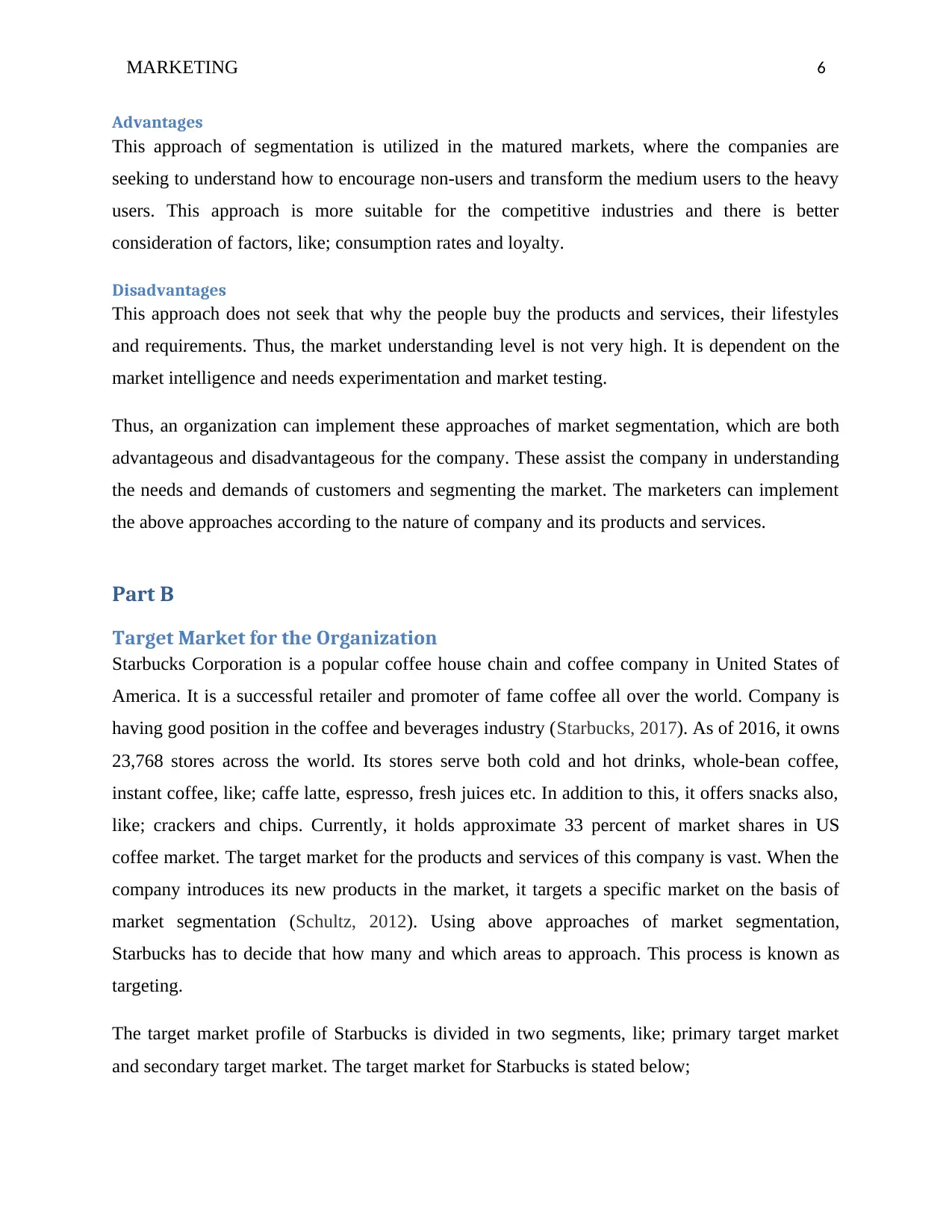
MARKETING 6
Advantages
This approach of segmentation is utilized in the matured markets, where the companies are
seeking to understand how to encourage non-users and transform the medium users to the heavy
users. This approach is more suitable for the competitive industries and there is better
consideration of factors, like; consumption rates and loyalty.
Disadvantages
This approach does not seek that why the people buy the products and services, their lifestyles
and requirements. Thus, the market understanding level is not very high. It is dependent on the
market intelligence and needs experimentation and market testing.
Thus, an organization can implement these approaches of market segmentation, which are both
advantageous and disadvantageous for the company. These assist the company in understanding
the needs and demands of customers and segmenting the market. The marketers can implement
the above approaches according to the nature of company and its products and services.
Part B
Target Market for the Organization
Starbucks Corporation is a popular coffee house chain and coffee company in United States of
America. It is a successful retailer and promoter of fame coffee all over the world. Company is
having good position in the coffee and beverages industry (Starbucks, 2017). As of 2016, it owns
23,768 stores across the world. Its stores serve both cold and hot drinks, whole-bean coffee,
instant coffee, like; caffe latte, espresso, fresh juices etc. In addition to this, it offers snacks also,
like; crackers and chips. Currently, it holds approximate 33 percent of market shares in US
coffee market. The target market for the products and services of this company is vast. When the
company introduces its new products in the market, it targets a specific market on the basis of
market segmentation (Schultz, 2012). Using above approaches of market segmentation,
Starbucks has to decide that how many and which areas to approach. This process is known as
targeting.
The target market profile of Starbucks is divided in two segments, like; primary target market
and secondary target market. The target market for Starbucks is stated below;
Advantages
This approach of segmentation is utilized in the matured markets, where the companies are
seeking to understand how to encourage non-users and transform the medium users to the heavy
users. This approach is more suitable for the competitive industries and there is better
consideration of factors, like; consumption rates and loyalty.
Disadvantages
This approach does not seek that why the people buy the products and services, their lifestyles
and requirements. Thus, the market understanding level is not very high. It is dependent on the
market intelligence and needs experimentation and market testing.
Thus, an organization can implement these approaches of market segmentation, which are both
advantageous and disadvantageous for the company. These assist the company in understanding
the needs and demands of customers and segmenting the market. The marketers can implement
the above approaches according to the nature of company and its products and services.
Part B
Target Market for the Organization
Starbucks Corporation is a popular coffee house chain and coffee company in United States of
America. It is a successful retailer and promoter of fame coffee all over the world. Company is
having good position in the coffee and beverages industry (Starbucks, 2017). As of 2016, it owns
23,768 stores across the world. Its stores serve both cold and hot drinks, whole-bean coffee,
instant coffee, like; caffe latte, espresso, fresh juices etc. In addition to this, it offers snacks also,
like; crackers and chips. Currently, it holds approximate 33 percent of market shares in US
coffee market. The target market for the products and services of this company is vast. When the
company introduces its new products in the market, it targets a specific market on the basis of
market segmentation (Schultz, 2012). Using above approaches of market segmentation,
Starbucks has to decide that how many and which areas to approach. This process is known as
targeting.
The target market profile of Starbucks is divided in two segments, like; primary target market
and secondary target market. The target market for Starbucks is stated below;
⊘ This is a preview!⊘
Do you want full access?
Subscribe today to unlock all pages.

Trusted by 1+ million students worldwide
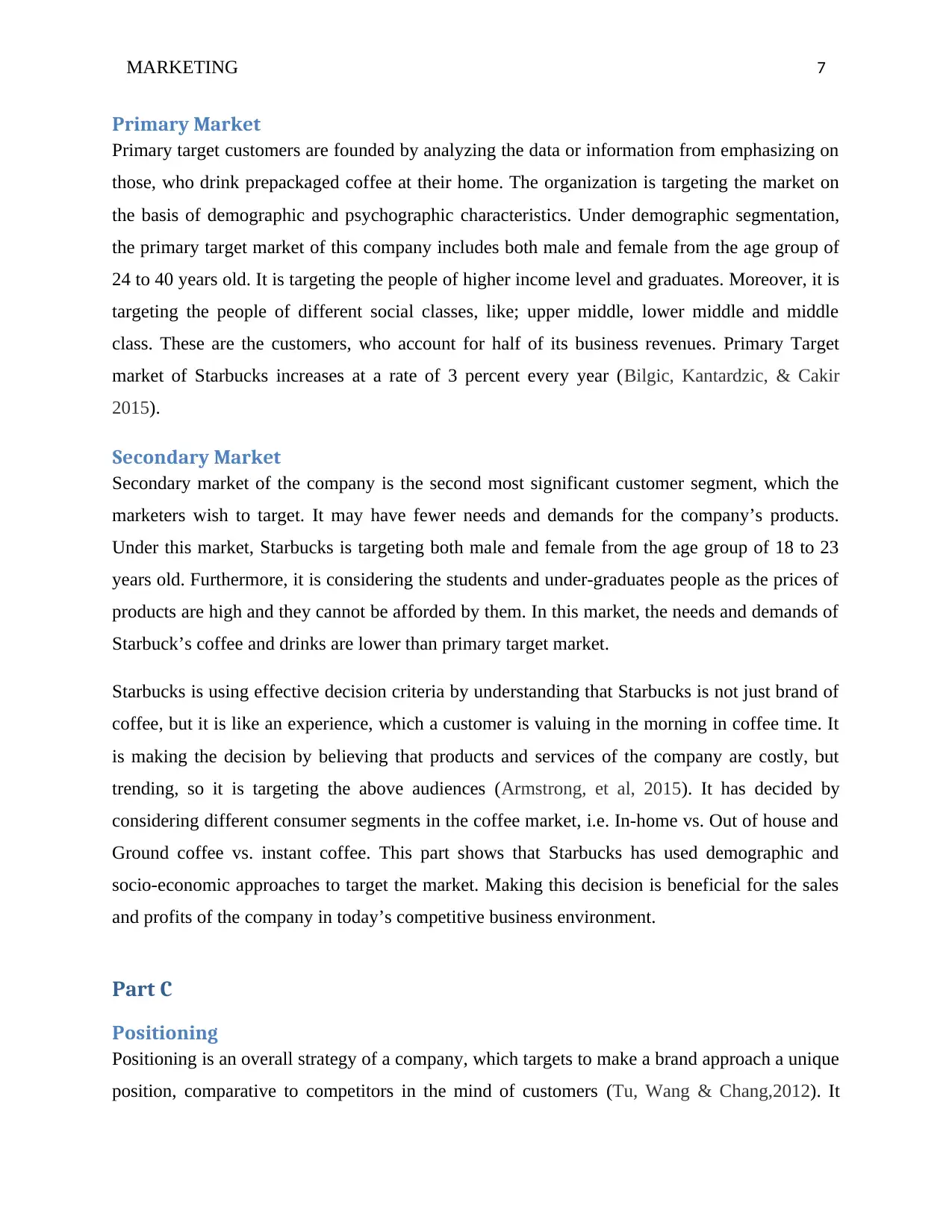
MARKETING 7
Primary Market
Primary target customers are founded by analyzing the data or information from emphasizing on
those, who drink prepackaged coffee at their home. The organization is targeting the market on
the basis of demographic and psychographic characteristics. Under demographic segmentation,
the primary target market of this company includes both male and female from the age group of
24 to 40 years old. It is targeting the people of higher income level and graduates. Moreover, it is
targeting the people of different social classes, like; upper middle, lower middle and middle
class. These are the customers, who account for half of its business revenues. Primary Target
market of Starbucks increases at a rate of 3 percent every year (Bilgic, Kantardzic, & Cakir
2015).
Secondary Market
Secondary market of the company is the second most significant customer segment, which the
marketers wish to target. It may have fewer needs and demands for the company’s products.
Under this market, Starbucks is targeting both male and female from the age group of 18 to 23
years old. Furthermore, it is considering the students and under-graduates people as the prices of
products are high and they cannot be afforded by them. In this market, the needs and demands of
Starbuck’s coffee and drinks are lower than primary target market.
Starbucks is using effective decision criteria by understanding that Starbucks is not just brand of
coffee, but it is like an experience, which a customer is valuing in the morning in coffee time. It
is making the decision by believing that products and services of the company are costly, but
trending, so it is targeting the above audiences (Armstrong, et al, 2015). It has decided by
considering different consumer segments in the coffee market, i.e. In-home vs. Out of house and
Ground coffee vs. instant coffee. This part shows that Starbucks has used demographic and
socio-economic approaches to target the market. Making this decision is beneficial for the sales
and profits of the company in today’s competitive business environment.
Part C
Positioning
Positioning is an overall strategy of a company, which targets to make a brand approach a unique
position, comparative to competitors in the mind of customers (Tu, Wang & Chang,2012). It
Primary Market
Primary target customers are founded by analyzing the data or information from emphasizing on
those, who drink prepackaged coffee at their home. The organization is targeting the market on
the basis of demographic and psychographic characteristics. Under demographic segmentation,
the primary target market of this company includes both male and female from the age group of
24 to 40 years old. It is targeting the people of higher income level and graduates. Moreover, it is
targeting the people of different social classes, like; upper middle, lower middle and middle
class. These are the customers, who account for half of its business revenues. Primary Target
market of Starbucks increases at a rate of 3 percent every year (Bilgic, Kantardzic, & Cakir
2015).
Secondary Market
Secondary market of the company is the second most significant customer segment, which the
marketers wish to target. It may have fewer needs and demands for the company’s products.
Under this market, Starbucks is targeting both male and female from the age group of 18 to 23
years old. Furthermore, it is considering the students and under-graduates people as the prices of
products are high and they cannot be afforded by them. In this market, the needs and demands of
Starbuck’s coffee and drinks are lower than primary target market.
Starbucks is using effective decision criteria by understanding that Starbucks is not just brand of
coffee, but it is like an experience, which a customer is valuing in the morning in coffee time. It
is making the decision by believing that products and services of the company are costly, but
trending, so it is targeting the above audiences (Armstrong, et al, 2015). It has decided by
considering different consumer segments in the coffee market, i.e. In-home vs. Out of house and
Ground coffee vs. instant coffee. This part shows that Starbucks has used demographic and
socio-economic approaches to target the market. Making this decision is beneficial for the sales
and profits of the company in today’s competitive business environment.
Part C
Positioning
Positioning is an overall strategy of a company, which targets to make a brand approach a unique
position, comparative to competitors in the mind of customers (Tu, Wang & Chang,2012). It
Paraphrase This Document
Need a fresh take? Get an instant paraphrase of this document with our AI Paraphraser
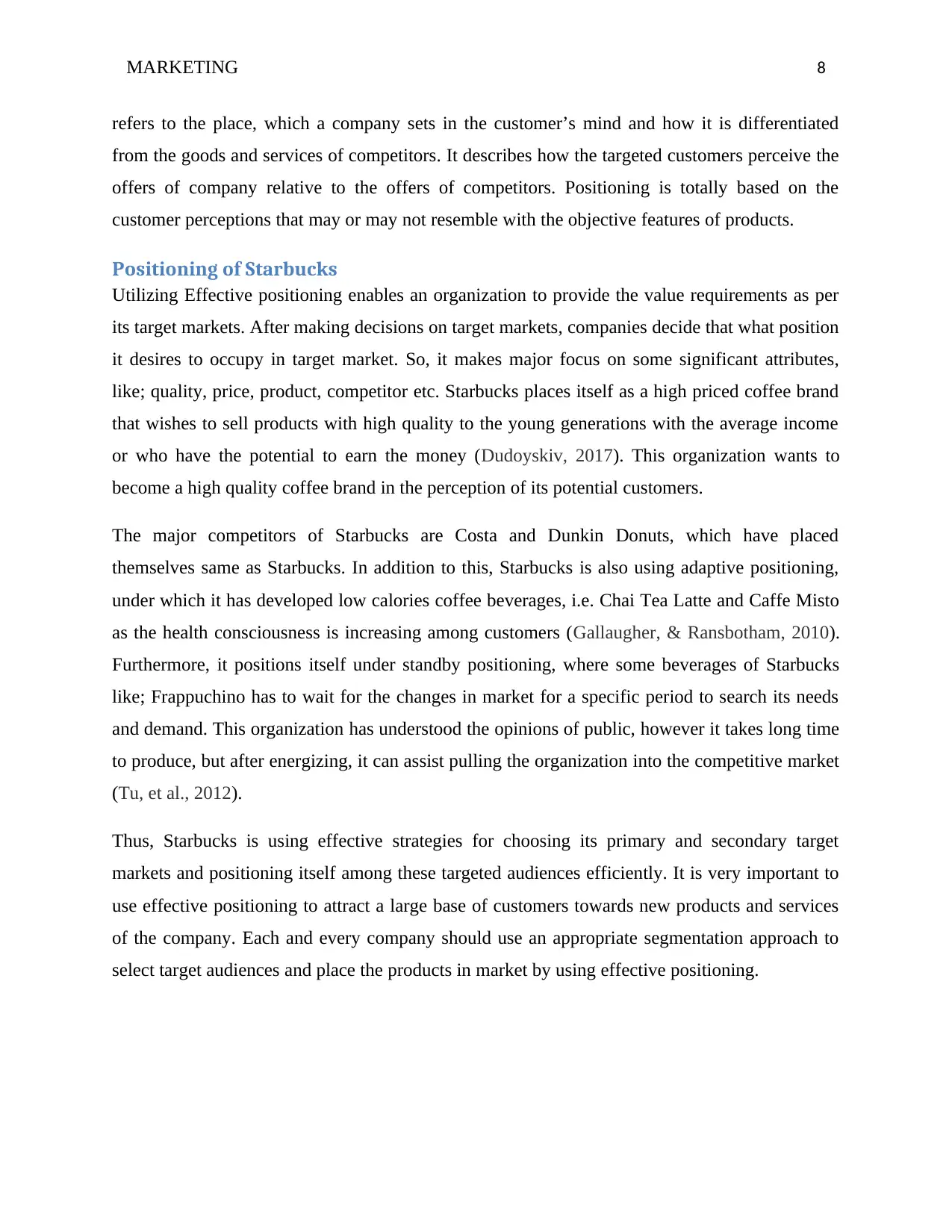
MARKETING 8
refers to the place, which a company sets in the customer’s mind and how it is differentiated
from the goods and services of competitors. It describes how the targeted customers perceive the
offers of company relative to the offers of competitors. Positioning is totally based on the
customer perceptions that may or may not resemble with the objective features of products.
Positioning of Starbucks
Utilizing Effective positioning enables an organization to provide the value requirements as per
its target markets. After making decisions on target markets, companies decide that what position
it desires to occupy in target market. So, it makes major focus on some significant attributes,
like; quality, price, product, competitor etc. Starbucks places itself as a high priced coffee brand
that wishes to sell products with high quality to the young generations with the average income
or who have the potential to earn the money (Dudoyskiv, 2017). This organization wants to
become a high quality coffee brand in the perception of its potential customers.
The major competitors of Starbucks are Costa and Dunkin Donuts, which have placed
themselves same as Starbucks. In addition to this, Starbucks is also using adaptive positioning,
under which it has developed low calories coffee beverages, i.e. Chai Tea Latte and Caffe Misto
as the health consciousness is increasing among customers (Gallaugher, & Ransbotham, 2010).
Furthermore, it positions itself under standby positioning, where some beverages of Starbucks
like; Frappuchino has to wait for the changes in market for a specific period to search its needs
and demand. This organization has understood the opinions of public, however it takes long time
to produce, but after energizing, it can assist pulling the organization into the competitive market
(Tu, et al., 2012).
Thus, Starbucks is using effective strategies for choosing its primary and secondary target
markets and positioning itself among these targeted audiences efficiently. It is very important to
use effective positioning to attract a large base of customers towards new products and services
of the company. Each and every company should use an appropriate segmentation approach to
select target audiences and place the products in market by using effective positioning.
refers to the place, which a company sets in the customer’s mind and how it is differentiated
from the goods and services of competitors. It describes how the targeted customers perceive the
offers of company relative to the offers of competitors. Positioning is totally based on the
customer perceptions that may or may not resemble with the objective features of products.
Positioning of Starbucks
Utilizing Effective positioning enables an organization to provide the value requirements as per
its target markets. After making decisions on target markets, companies decide that what position
it desires to occupy in target market. So, it makes major focus on some significant attributes,
like; quality, price, product, competitor etc. Starbucks places itself as a high priced coffee brand
that wishes to sell products with high quality to the young generations with the average income
or who have the potential to earn the money (Dudoyskiv, 2017). This organization wants to
become a high quality coffee brand in the perception of its potential customers.
The major competitors of Starbucks are Costa and Dunkin Donuts, which have placed
themselves same as Starbucks. In addition to this, Starbucks is also using adaptive positioning,
under which it has developed low calories coffee beverages, i.e. Chai Tea Latte and Caffe Misto
as the health consciousness is increasing among customers (Gallaugher, & Ransbotham, 2010).
Furthermore, it positions itself under standby positioning, where some beverages of Starbucks
like; Frappuchino has to wait for the changes in market for a specific period to search its needs
and demand. This organization has understood the opinions of public, however it takes long time
to produce, but after energizing, it can assist pulling the organization into the competitive market
(Tu, et al., 2012).
Thus, Starbucks is using effective strategies for choosing its primary and secondary target
markets and positioning itself among these targeted audiences efficiently. It is very important to
use effective positioning to attract a large base of customers towards new products and services
of the company. Each and every company should use an appropriate segmentation approach to
select target audiences and place the products in market by using effective positioning.
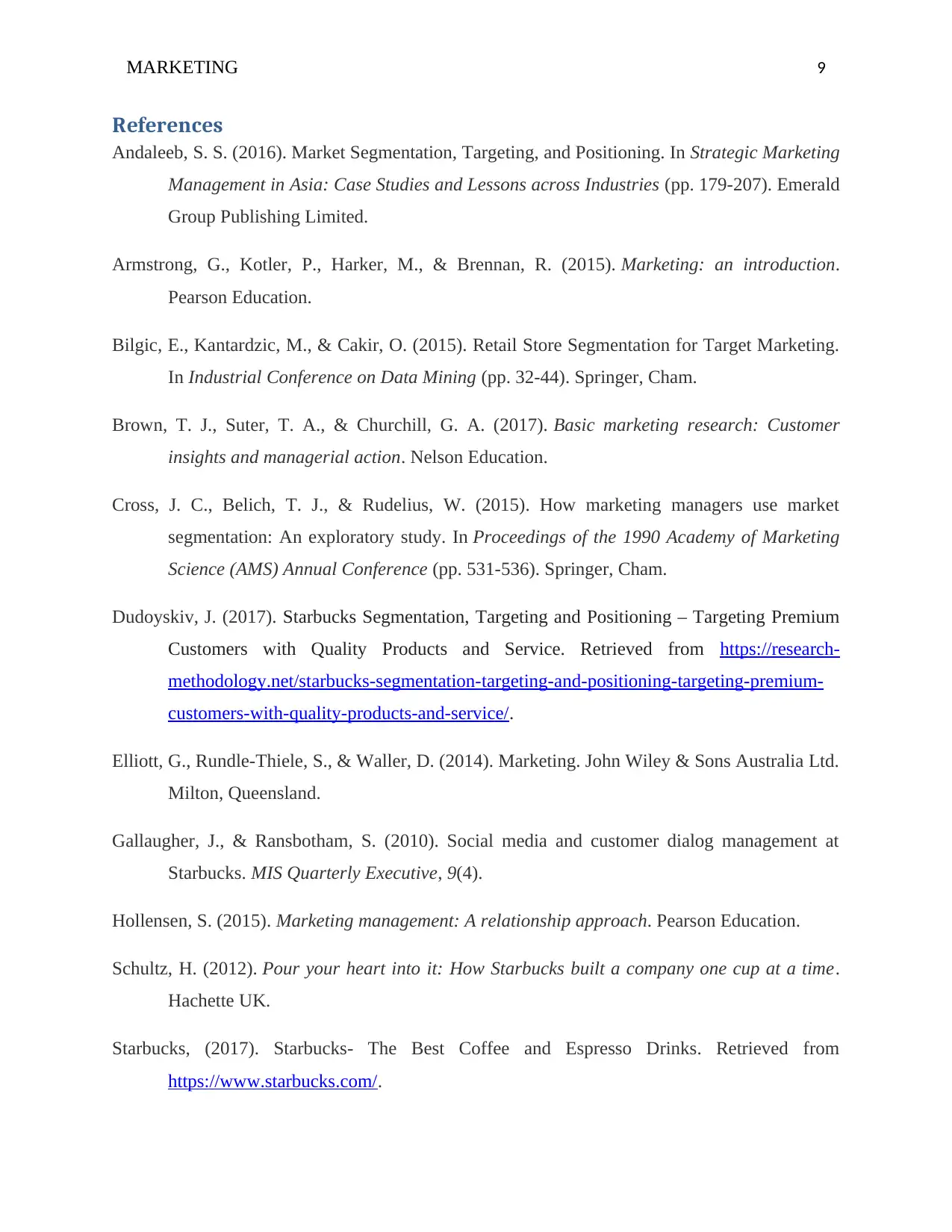
MARKETING 9
References
Andaleeb, S. S. (2016). Market Segmentation, Targeting, and Positioning. In Strategic Marketing
Management in Asia: Case Studies and Lessons across Industries (pp. 179-207). Emerald
Group Publishing Limited.
Armstrong, G., Kotler, P., Harker, M., & Brennan, R. (2015). Marketing: an introduction.
Pearson Education.
Bilgic, E., Kantardzic, M., & Cakir, O. (2015). Retail Store Segmentation for Target Marketing.
In Industrial Conference on Data Mining (pp. 32-44). Springer, Cham.
Brown, T. J., Suter, T. A., & Churchill, G. A. (2017). Basic marketing research: Customer
insights and managerial action. Nelson Education.
Cross, J. C., Belich, T. J., & Rudelius, W. (2015). How marketing managers use market
segmentation: An exploratory study. In Proceedings of the 1990 Academy of Marketing
Science (AMS) Annual Conference (pp. 531-536). Springer, Cham.
Dudoyskiv, J. (2017). Starbucks Segmentation, Targeting and Positioning – Targeting Premium
Customers with Quality Products and Service. Retrieved from https://research-
methodology.net/starbucks-segmentation-targeting-and-positioning-targeting-premium-
customers-with-quality-products-and-service/.
Elliott, G., Rundle-Thiele, S., & Waller, D. (2014). Marketing. John Wiley & Sons Australia Ltd.
Milton, Queensland.
Gallaugher, J., & Ransbotham, S. (2010). Social media and customer dialog management at
Starbucks. MIS Quarterly Executive, 9(4).
Hollensen, S. (2015). Marketing management: A relationship approach. Pearson Education.
Schultz, H. (2012). Pour your heart into it: How Starbucks built a company one cup at a time.
Hachette UK.
Starbucks, (2017). Starbucks- The Best Coffee and Espresso Drinks. Retrieved from
https://www.starbucks.com/.
References
Andaleeb, S. S. (2016). Market Segmentation, Targeting, and Positioning. In Strategic Marketing
Management in Asia: Case Studies and Lessons across Industries (pp. 179-207). Emerald
Group Publishing Limited.
Armstrong, G., Kotler, P., Harker, M., & Brennan, R. (2015). Marketing: an introduction.
Pearson Education.
Bilgic, E., Kantardzic, M., & Cakir, O. (2015). Retail Store Segmentation for Target Marketing.
In Industrial Conference on Data Mining (pp. 32-44). Springer, Cham.
Brown, T. J., Suter, T. A., & Churchill, G. A. (2017). Basic marketing research: Customer
insights and managerial action. Nelson Education.
Cross, J. C., Belich, T. J., & Rudelius, W. (2015). How marketing managers use market
segmentation: An exploratory study. In Proceedings of the 1990 Academy of Marketing
Science (AMS) Annual Conference (pp. 531-536). Springer, Cham.
Dudoyskiv, J. (2017). Starbucks Segmentation, Targeting and Positioning – Targeting Premium
Customers with Quality Products and Service. Retrieved from https://research-
methodology.net/starbucks-segmentation-targeting-and-positioning-targeting-premium-
customers-with-quality-products-and-service/.
Elliott, G., Rundle-Thiele, S., & Waller, D. (2014). Marketing. John Wiley & Sons Australia Ltd.
Milton, Queensland.
Gallaugher, J., & Ransbotham, S. (2010). Social media and customer dialog management at
Starbucks. MIS Quarterly Executive, 9(4).
Hollensen, S. (2015). Marketing management: A relationship approach. Pearson Education.
Schultz, H. (2012). Pour your heart into it: How Starbucks built a company one cup at a time.
Hachette UK.
Starbucks, (2017). Starbucks- The Best Coffee and Espresso Drinks. Retrieved from
https://www.starbucks.com/.
⊘ This is a preview!⊘
Do you want full access?
Subscribe today to unlock all pages.

Trusted by 1+ million students worldwide
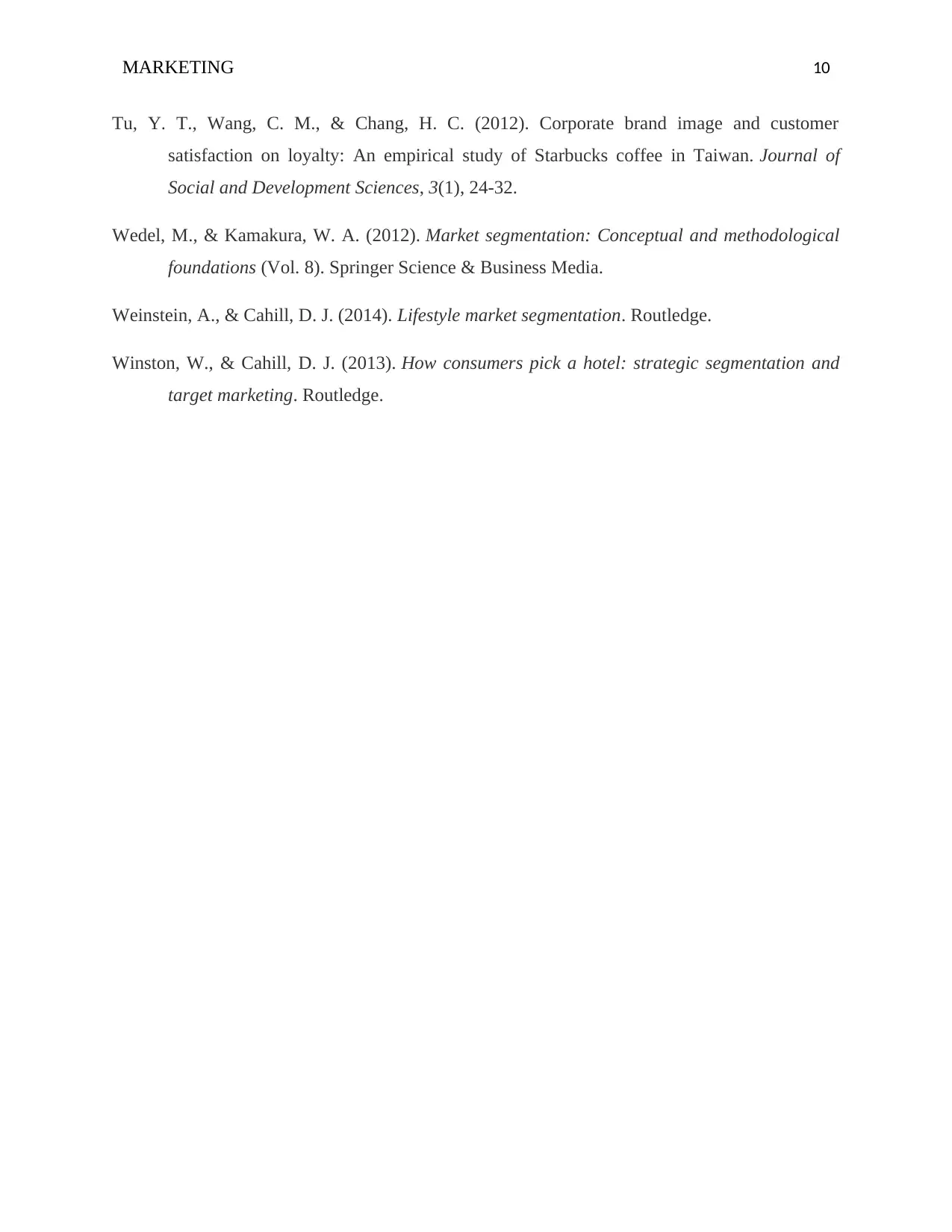
MARKETING 10
Tu, Y. T., Wang, C. M., & Chang, H. C. (2012). Corporate brand image and customer
satisfaction on loyalty: An empirical study of Starbucks coffee in Taiwan. Journal of
Social and Development Sciences, 3(1), 24-32.
Wedel, M., & Kamakura, W. A. (2012). Market segmentation: Conceptual and methodological
foundations (Vol. 8). Springer Science & Business Media.
Weinstein, A., & Cahill, D. J. (2014). Lifestyle market segmentation. Routledge.
Winston, W., & Cahill, D. J. (2013). How consumers pick a hotel: strategic segmentation and
target marketing. Routledge.
Tu, Y. T., Wang, C. M., & Chang, H. C. (2012). Corporate brand image and customer
satisfaction on loyalty: An empirical study of Starbucks coffee in Taiwan. Journal of
Social and Development Sciences, 3(1), 24-32.
Wedel, M., & Kamakura, W. A. (2012). Market segmentation: Conceptual and methodological
foundations (Vol. 8). Springer Science & Business Media.
Weinstein, A., & Cahill, D. J. (2014). Lifestyle market segmentation. Routledge.
Winston, W., & Cahill, D. J. (2013). How consumers pick a hotel: strategic segmentation and
target marketing. Routledge.
1 out of 10
Related Documents
Your All-in-One AI-Powered Toolkit for Academic Success.
+13062052269
info@desklib.com
Available 24*7 on WhatsApp / Email
![[object Object]](/_next/static/media/star-bottom.7253800d.svg)
Unlock your academic potential
Copyright © 2020–2025 A2Z Services. All Rights Reserved. Developed and managed by ZUCOL.





